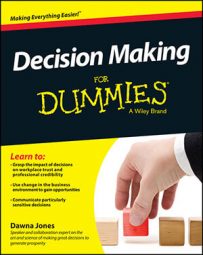Successful companies are ones that recognize and deal effectively with risk. Whether risk works for or against effective decision-making depends on how you work with it. After all, risk is a matter of perception, and people perceive risk differently.
A great deal of how you perceive risk is based on factors outside your conscious awareness. The point? All the rational data in the world won’t save a decision-maker from how humans think.
People place more weight on potential losses than on gains.
People in their personal lives and in business weigh — either consciously or subconsciously — the risk of loss over the potential gain. They weigh the risk of losing all they’ve built or acquired against the likelihood of a future reward that is intangible and uncertain, and often opt to protect what they have over going for the uncertain future benefit.
This tendency has value for two reasons: One, you can observe when the risk of losing leads to risk aversion, enabling you to intentionally decide whether to override fear of losing to make a bold decision. Second, by recognizing that employees will be listening for what they’ll lose rather than what they’ll gain, you can tailor your message when you communicate changes.
When communicating decisions on a new change initiative, don’t simply sell them on the benefits of the change. Doing so doesn't meet the emotional need to know how the change impacts what they have, know, and are comfortable with now. Instead, explaining how their experience and expertise will build value or contribute to the change helps employees feel more comfortable.
The more people have, the more risk averse they become.
In personal life, you’ve worked hard to build up your lifestyle, acquire possessions, and live the way you want. You’re not going to be that interested in losing it all by taking a risk, even when you know changing is the smart thing to do. Similarly, the longer a company is in existence, the more it has to lose when presented with an opportunity that is accompanied by high risk.
Fear of losing market share results in a higher level of risk aversion and jeopardizes the company’s ability to stay nimble in the face of coming changes. A risk-averse company becomes protective and, as a result, stagnates. Decision-making leans toward meeting internal goals rather than customer needs or employee values.
Even though the pressure to change is evident and obvious, fear of losing what’s been gained so far will be in conflict with taking the risk to change.
When people have no control over the risk they’re being asked to accept, they perceive the risk as greater.
If employees don’t feel that they have any control or say in the matter, they tend to view the situation as highly stressful and saturated with risk. They may go through the motions to implement a plan or directive, but no one’s heart is in it. Consider the difference between deciding you want to learn how to ski versus being pushed down the mountain.
You make life easier for everyone by engaging employees as the true architects of the change. People do not resist change, but they do fight change that is imposed upon them or that feels unfair. If you haven’t genuinely involved them, at least communicate the decision about impending change by explaining how past and current practices connect to the direction.
That way you can help your employees see how their past experience and expertise fit into what lies ahead.
People prefer a path of least resistance.
Continuing to do what you’ve been doing is easier than venturing into new territory. The path of least resistance is defined by predictability and certainty. Maintaining the status quo seems preferable to taking an active stance toward adapting or stretching into new terrain.
This approach lasts until a crisis leaves no other choice. Uncertainty, while often feared, is the juice for creative exploration and experimentation; it allows a decision-maker to do something different, exciting, and exhilarating.
If your organization has created passive employees who wait to be told what to do, then those employees will do what they’ve always done because taking the initiative in a command-and-control setting can have career-limiting consequences and be emotionally unsafe.
To help transition passive employees into ones who are more active and involved, ask questions that elicit solutions from them. If they don’t respond right away, stick with the line of questioning and be patient.
Remember, your company’s culture and management style has trained employees to be risk averse and passive.
The further into the future you go, the less certain things appear.
Human beings are short-sighted. The farther we look into the future, the less certain everything appears. As a result, we tend to discount future risk because it isn’t concrete, viewing it as just a fuzzy possibility that may or may not happen. (This tendency explains why taking action to mitigate climate change was stalled in the mid-1980s and why people still eat too much fried food!)
Additionally, when risk is described in clinical terms that use mind-numbing numbers, it’s even easier to discount. But translate that risk into more specific terms, and the image gets much sharper. The more specific the risk, the more real it seems, regardless of how likely it is to take place. Chances you’re more inclined to buy travel insurance that covers a terrorist attack than to buy it “just in case.”
To counter these tendencies, work with your employees to generate scenarios that feature the possible risks and then treat them as if they are real. Doing so fosters better decisions.

